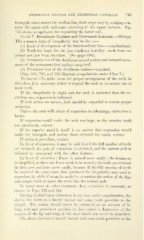Page 747 - My FlipBook
P. 747
—
—
PROMINENT CANINES AND DEPRESSED LATERALS. 745
bicuspids move nearer the median line, their cusps may by wedging con-
tract the upper arch and cause crowding of the upper incisors. Fig.
733 shows an appliance for expanding the lower arch.
Class 7. Prominent Canines and Depressed Laterals. Etiology.
This common form of irregularity may be due to
(a) Lack of development of the intermaxillary bone—constitutional.
(6) Teeth too large for the jaw—indirect heredity : teeth from one
parent and jaw from the other. (See page 690.)
(c) Premature loss of the deciduous second molars and forward move-
ment of the permanent first molars—acquired.
(d) Premature loss of the deciduous canines—acquired.
(Figs. 605, 723, and 725 illustrate irregularities under Class 7.)
Treatment.—To make room for proper arrangement of the teeth in
this class, it is necessary either to expand the arch or to extract one or
more teeth.
If the irregularity is slight, and the arch is narrower than the oc-
cluding one, expansion is indicated.
If both arches are narrow, both should be expanded to restore proper
occlusion.
Unless the arch will admit of expansion to advantage, extraction is
better.
If expansion would make the arch too large, or the anterior teeth
too prominent, extract.
If the superior maxilla itself is so narrow that expansion M'ould
make the bicuspids and molars slant outward too much, extract.
If caries is prevalent, extract.
In favor of expansion, it may be said that if the full number of teeth
are retained, the pain of extraction is obviated, and the narrow arch is
widened to correspond with the other features.
In favor of extraction : Room is gained more easily ; the treatment
is simplified, as there are fewer teeth to be moved ; the teeth are retained
in their new positions more easily, because if the full number of teeth
be retained the same cause that produced the irregularity may tend to
reproduce it, while if room be made by extraction the action of the lips
and tongue tends to move the teeth into the normal arch.
In many cases no other treatment than extraction is necessary, as
shown in Figs. 723 and 724.
Having decided upon extraction in any case under consideration, the
choice lies between a lateral incisor and some tooth posterior to the
cuspid. The canine should never be extracted, as on account of its
long root and prominent position its loss causes a depression of the
corners of the lip and wing of the nose which can never be remedied.
The choice between a lateral incisor and some tooth posterior to the
—
PROMINENT CANINES AND DEPRESSED LATERALS. 745
bicuspids move nearer the median line, their cusps may by wedging con-
tract the upper arch and cause crowding of the upper incisors. Fig.
733 shows an appliance for expanding the lower arch.
Class 7. Prominent Canines and Depressed Laterals. Etiology.
This common form of irregularity may be due to
(a) Lack of development of the intermaxillary bone—constitutional.
(6) Teeth too large for the jaw—indirect heredity : teeth from one
parent and jaw from the other. (See page 690.)
(c) Premature loss of the deciduous second molars and forward move-
ment of the permanent first molars—acquired.
(d) Premature loss of the deciduous canines—acquired.
(Figs. 605, 723, and 725 illustrate irregularities under Class 7.)
Treatment.—To make room for proper arrangement of the teeth in
this class, it is necessary either to expand the arch or to extract one or
more teeth.
If the irregularity is slight, and the arch is narrower than the oc-
cluding one, expansion is indicated.
If both arches are narrow, both should be expanded to restore proper
occlusion.
Unless the arch will admit of expansion to advantage, extraction is
better.
If expansion would make the arch too large, or the anterior teeth
too prominent, extract.
If the superior maxilla itself is so narrow that expansion M'ould
make the bicuspids and molars slant outward too much, extract.
If caries is prevalent, extract.
In favor of expansion, it may be said that if the full number of teeth
are retained, the pain of extraction is obviated, and the narrow arch is
widened to correspond with the other features.
In favor of extraction : Room is gained more easily ; the treatment
is simplified, as there are fewer teeth to be moved ; the teeth are retained
in their new positions more easily, because if the full number of teeth
be retained the same cause that produced the irregularity may tend to
reproduce it, while if room be made by extraction the action of the lips
and tongue tends to move the teeth into the normal arch.
In many cases no other treatment than extraction is necessary, as
shown in Figs. 723 and 724.
Having decided upon extraction in any case under consideration, the
choice lies between a lateral incisor and some tooth posterior to the
cuspid. The canine should never be extracted, as on account of its
long root and prominent position its loss causes a depression of the
corners of the lip and wing of the nose which can never be remedied.
The choice between a lateral incisor and some tooth posterior to the


